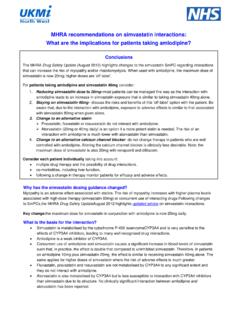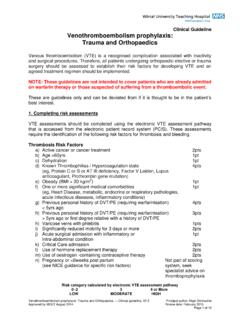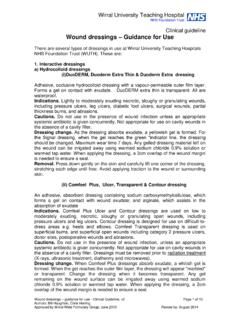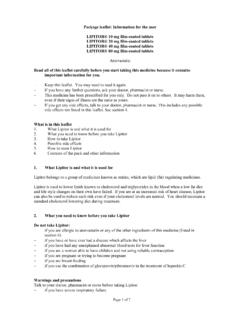Transcription of Clinical Guideline Pain Management
1 Clinical Guideline Pain Management This guidance covers: WHO Analgesic Ladder Reducing dosing errors with opioids Opioid toxicity General Pain Management Acute General Pain Management Postoperative (excluding obstetrics). General Pain Management Obstetrics (NOT for women in labour). General Pain Management Chronic General Pain Management Renal Patients Analgesic subcutaneous syringe drivers Co-prescribing with opioids Appendix 1: Dose conversion chart for strong opioids WHO Analgesic Ladder The WHO analgesic ladder is a validated system for treating pain. +/- Adjuvant: NSAID. Pain Persisting or Increasing Step 3. Moderate to Severe Pain Strong Opioid: Morphine Sulphate, Diamorphine, Fentanyl + non opioid Step 2. Mild to Moderate Pain Weak Opioid: Codeine, Dihydrocodeine, Tramadol + non opioid Step 1.
2 Mild Pain Non Opioid Analgesia: Paracetamol Pain Management Clinical Guidelines, Version2 Principal author: Karen Herbert, Lead Pharmacist, Medicines Management Approved by Wirral Drug & Therapeutic Committee: July 2010 Review date: July 2013 Page 1 of 15. Reducing Dosing Errors with Opioids This guidance has been produced in response to a National Patient Safety Agency Rapid Response Report, which was issued due to the increase in number and severity of incidents concerning opioid medicines. The following must be followed when prescribing, dispensing or administering opioid medicines: Confirm any recent opioid dose, formulation, frequency of administration and any other analgesic medicines prescribed for the patient.
3 Ensure where a dose increase is intended, that the calculated dose is safe for the patient. Check the usual starting dose, frequency of administration, standard dosing increments, symptoms of overdose, and common side effects of that medicine and formulation. Opioid Toxicity If administering strong opiates then naloxone (the antidote) must be available. Symptoms of opioid toxicity include: respiratory depression, hypotension, circulatory failure, coma, convulsions, rhabdomylosis, renal failure, pinpoint pupils, agitation, vivid dreams, nightmares, hallucinations, confusion and myoclonic jerks. The specific antidote naloxone is indicated if there is coma or bradypnoea. Since naloxone has a shorter duration of action than many opioids, close monitoring and repeated injections are necessary according to the respiratory rate and depth of coma.
4 When repeated administration of naloxone is required, it can be given by continuous intravenous infusion instead and the rate of infusion adjusted according to vital signs. Doses of naloxone for opioid overdosage: By intravenous injection, 400micrograms 2 mg; if no response repeat at intervals of 2 3. minutes to a maximum of 10 mg, then review diagnosis. Further doses may be required if respiratory function deteriorates By subcutaneous or intramuscular injection, dose as for intravenous injection but use only if intravenous route not feasible (onset of action slower). By continuous intravenous infusion using an infusion pump, 4 mg diluted in 20 mL. intravenous infusion solution [unlicensed concentration] at a rate adjusted according to response (initial rate may be set at 60% of initial intravenous injection dose (see above).)
5 And infused over 1 hour). In palliative care and chronic opioid use lower doses should be used to manage opioid-induced respiratory depression and sedation, while maintaining adequate analgesia: By intravenous injection, 100 200micrograms; given at 2 to 3 minute intervals Additional doses may be necessary at one to two hour intervals depending on the response of the patient and the dosage and duration of action of the opioid administered. Pain Management Clinical Guidelines, Version2 Principal author: Karen Herbert, Lead Pharmacist, Medicines Management Approved by Wirral Drug & Therapeutic Committee: July 2010 Review date: July 2013 Page 2 of 15. General Pain Management Acute Mild Paracetamol 1g orally or rectally every 4 to 6 hours.
6 Max 4g daily. Moderate Paracetamol 1g orally or rectally every 4 to 6 hours. Max 4g daily +. Codeine 30 to 60mg orally every 4 to 6 hours (Combination product available: Co-codamol 30/500mg One to two tablets, orally, every 4 to 6. hours. Maximum: 8 tablets daily). or Tramadol 50 to 100mg orally every 6 hours (For patients taking regular tramadol: Tramadol MR 100 to 200mg, orally, twice a day). +/- NSAID - Ibuprofen 400mg, orally, every 6 to 8 hours (Diclofenac MR 75mg, orally, twice daily may be considered in patients with cancer). Severe Paracetamol 1g orally or rectally every 4 to 6 hours. Max 4g daily +. Morphine sulphate oral solution 10mg/5mL. 5 to 10mg every 4 hours when required If oral route not possible: give to 5mg of morphine sulphate injection intramuscularly (IM) every 4 hours or IV hourly when required.
7 (and STOP any weak opioids eg, codeine or tramadol). +/- NSAID - Ibuprofen 400mg every 6 to 8 hours General points: When mild analgesics fail, change to a stronger analgesic further up the pain ladder. Do not change to a drug of similar potency; this will not achieve better pain control. Combinations of analgesics with different mechanisms of action are more effective than single agents. Continuous pain warrants continuous analgesia, avoid prescriptions for when required analgesia. Prescribe a regular dose. Intermittent pain warrants intermittent analgesia. Patients should have their pain control regularly assessed. Consider new presentations of pain eg: neuropathic pain - see Neuropathic Pain Guidelines. Pain Management Clinical Guidelines, Version2 Principal author: Karen Herbert, Lead Pharmacist, Medicines Management Approved by Wirral Drug & Therapeutic Committee: July 2010 Review date: July 2013 Page 3 of 15.
8 General Pain Management postoperative (excluding obstetrics). Mild Paracetamol 1g orally or rectally every 4 to 6 hours. Max 4g daily. Intravenous paracetamol stat dose can be used in post-operative patients who are unable to swallow, or unable to use or refuse suppositories. Under 50 kg: 15mg/kg by intravenous (IV) infusion over 15 minutes every 4 to 6 hours. Max. 3g daily. Over 50 kg: 1g by IV infusion over 15 minutes every 4 to 6 hours. Max. 4g daily Moderate Paracetamol 1g orally or rectally every 4 to 6 hours. Max 4g daily. +. Codeine 30 to 60mg orally every 4 to 6 hours (Combination product available: Co-codamol 30/500mg One to two tablets, orally, every 4 to 6. hours. Maximum: 8 tablets daily). or Tramadol 50 to 100mg orally every 6 hours (For patients taking regular tramadol: Tramadol MR 100 200mg, orally, twice a day).
9 +/- NSAID - Ketoprofen 100mg bd orally/rectally/intramuscularly (inpatients only for upto 3 days, then switch to either diclofenac or ibuprofen if NSAID still required. Diclofenac 50mg tds orally, 75 to150mg daily in divided doses rectally, Ibuprofen 400mg orally three times a day NSAIDs may enhance anticoagulant effect of anticoagulants but can be concurrently prescribed with prophylaxis doses of LMWH. Diclofenac 75mg in 2ml (Dyloject ) IV injection is available for use in THEATRE ONLY for use in anaesthetised patients. Note: IV Diclofenac is contra-indicated in patients receiving concomitant NSAIDs including cyclooxygenase-2 selective inhibitors or anticoagulant use (including low dose heparin). For full prescribing information Diclofenac Injection BP 75mg/3ml - Summary of Product Characteristics (SPC) - electronic Medicines compendium (eMC).)
10 Severe Paracetamol 1g orally or rectally every 4 to 6 hours. Max 4g daily. Or use IV paracetamol (for dosing see under mild pain). +. Morphine sulphate oral solution 10mg/5mL 5 to 10mg every 4 hours when required If oral route not possible: give to 5mg of morphine sulphate injection intramuscularly (IM) every 4 hours or IV hourly when required. (And STOP any weak opioids eg, codeine or tramadol). +/- NSAID Diclofenac 50mg tds orally, 75-150mg daily in divided doses rectally Ibuprofen 400mg every 6 to 8 hours Pain Management Clinical Guidelines, Version2 Principal author: Karen Herbert, Lead Pharmacist, Medicines Management Approved by Wirral Drug & Therapeutic Committee: July 2010 Review date: July 2013 Page 4 of 15. Severe for patients deemed suitable by the Acute Pain Team or an Anaesthetist Paracetamol 1g orally or rectally every 4 to 6 hours.













